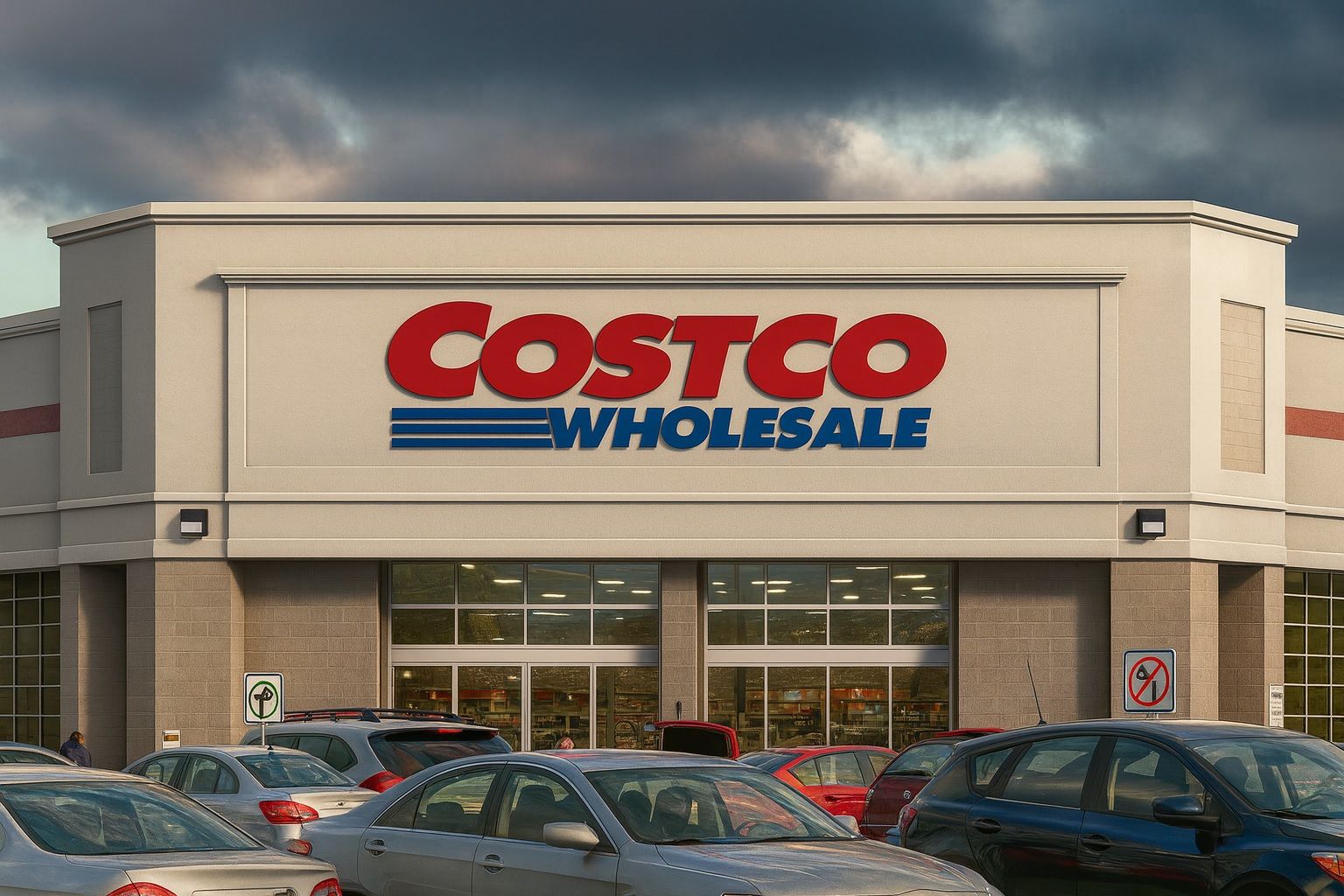- Current Price (Oct 19, 2025): COST closed at $936.33 on Oct 17, 2025 [1] (up ~1.2% that day), roughly flat year-to-date after hitting an all-time high near $1,078 in mid-2025 [2].
- Q4 Results (FY2025): Fiscal Q4 sales were about $84.4 billion (+8% YoY) with EPS $5.87 (up 11% YoY), both beating analyst forecasts [3] [4]. Membership fee revenue jumped 14% to $1.72 billion, bolstering profits [5].
- September Sales Surge: October 9th data showed Sept. net sales of $26.58 billion (up ~8% YoY) [6], with comparable store sales +5–6%. The strong month, led by both in-store and e-commerce growth, eased concerns of a post-summer slowdown and briefly lifted the stock into the low-$920s [7].
- Store Expansion: Costco is aggressively growing its warehouse footprint. Plans call for 35 new warehouses in FY2026 (ending Aug 2026), which is 30 net-new stores plus 5 relocations [8]. This follows 27 openings last year and builds on 914 total warehouses today (629 in the U.S.) [9]. In late Oct 2025 the company will open four more locations – Fruitport (MI), Mechanicsburg (PA), Indian Land (SC) and a Business Center in Mississauga (Ontario) [10] – as part of this expansion. Costco CEO Ron Vachris says the company sees “significant opportunities for expansion, both domestically and internationally” [11]. CFO Gary Millerchip adds that many U.S. stores are ~20 years old, so relocating stores “presents an opportunity for us to refresh and to support continued best-in-class service” [12].
- Analyst Outlook: Wall Street is mostly bullish on COST. About 30 analysts cover Costco, with the consensus rating a Buy/Hold (no one has a Sell) and an average 12-month price target around $1,050–$1,070 [13] [14] (~10–15% upside). For example, financial analysts at Goldman Sachs lifted their target to $1,133 on Costco’s Q3 results [15], and Morgan Stanley maintains a $1,225 target [16]. StockAnalysis.com reports an average target of $1,066 (about +14% above current levels) [17]. By contrast, a few firms urge caution on valuation even as they admire Costco’s fundamentals.
Costco’s stock trades at a premium multiple of roughly 50× trailing earnings (about 30× forward EPS) [18] [19], well above peers like Walmart (~34×) and Target (~11×). Bulls argue this rich valuation is justified by Costco’s steady growth, strong membership economics and defensive “bulk discount” model [20] [21]. Skeptics warn the shares could be “priced for perfection,” meaning any consumer slowdown or earnings miss might trigger a pullback [22] [23].
Strong Q4 Results and Member Spending
Costco’s late September earnings were a highlight. For the quarter ended Aug 31, total revenue was $86.16 billion, just above the $86.06 billion consensus [24]. Earnings on a per-share basis ($5.87) beat the $5.80 estimate [25] [26]. Same-store sales (ex‑gas) rose 6.4%, roughly in line with expectations [27]. Importantly, Costco’s membership-fee income – a high-margin revenue stream – climbed 14% to $1.72 billion in the quarter [28] (reflecting last year’s fee hike). As Reuters noted, CFRA Research analyst Arun Sundaram called Costco’s approach a “win-win for both members and shareholders,” since Costco appears to reinvest part of the fee bump back into lower prices while the rest adds to profit [29]. Omnisend retail expert Greg Zakowicz added that Costco’s strategy (including local sourcing and a tight product assortment) “positions them well for a strong holiday shopping season,” as Costco navigates tariffs and consumer belt‑tightening [30] [31].
Despite beating top-line forecasts, Costco’s stock actually dipped about 3% after hours on the earnings report. Managers noted that U.S. customers were slightly pulling back on discretionary categories (like electronics and jewelry) amid rising costs, which tempered an otherwise very strong quarter [32] [33]. For example, e-commerce grew +13.6%, but some in-store “treasure hunt” items had slower sales, prompting management to adopt a cautious tone. (The effects were short-lived, however.) By early October, another positive catalyst arrived – the September sales data – which drove COST back up. In early trading on Oct 9, after reporting $26.58 billion in net sales for September (+8% YoY, comps ~+5–6%), Costco shares jumped back into the low-$920s [34] [35], as analysts and investors cheered evidence that consumer demand for low-cost essentials remained firm.
Aggressive Store Growth and Member Benefits
Costco is using its robust earnings to fuel growth. Already the company operates 914 warehouses worldwide, and management is accelerating store openings to relieve crowding and tap new markets. For fiscal 2026 (year ending Aug 2026), Costco plans 35 new warehouses [36] [37]. This includes 30 net-new stores and 5 relocations of existing clubs into larger facilities [38] [39]. CEO Ron Vachris said on the Q4 earnings call that the “right opportunities have come” for expansion and that the company continues to see “significant opportunities for expansion, both domestically and internationally” [40] [41]. Indeed, RetailTouchpoints reports the retailer opened 24 new stores in FY2025 and will open 35 in FY2026 [42] – a big jump relative to its historical pace of ~25–30 per year.
Many of the new locations are aimed at relieving busy existing clubs. Business Insider notes that Costco often places a new warehouse near a high-traffic one to siphon off excess demand, essentially “strategically cannibalizing” sales to improve service and parking for members [43]. In practice, the first four of Costco’s FY2026 openings are slated for late October 2025: Fruitport (MI), Mechanicsburg (PA), Indian Land (SC), and a Costco Business Center in Mississauga, Ontario [44]. These openings follow seven new stores in August 2025 in the U.S., Canada and Mexico, and continue the trend noted by CFO Gary Millerchip: “The average warehouse now in the US … is around 20 years old,” so relocations and new builds are needed to refresh older sites [45].
Costco isn’t just expanding real estate; it is also boosting membership value. Perks like new private-label foods, partnerships for healthcare and home services, and even a new one-ounce gold bar offering have generated buzz [46] [47]. (Costco selling gold bars online at ~$1,900 each has drawn media attention – the bars often sell out immediately, moving over $200 million of precious metals per month [48].) These “treasure hunt” deals and service enhancements help justify Costco’s membership fees (around 90% of members renew, a historic high [49]) and keep customers loyal. TS2.tech notes that Costco now has over 81 million paid members (up ~7% YoY) [50], and membership fee income for FY2025 reached a record $4.5 billion (including Q4’s $1.72B) [51]. That recurring fee income (nearly pure profit) underpins Costco’s business model: executives freely reinvest parts of it into price cuts and service while still fattening profits [52] [53].
Analyst Views and Stock Outlook
In the wake of these developments, analysts remain generally optimistic on COST. No major Wall Street firm has downgraded the name to Sell; most rate it Buy or Overweight. The consensus 12‑month price target is roughly $1,050–$1,070 [54] [55]. For example, UBS recently reiterated a $1,205 target (Buy), highlighting Costco’s membership economics and extended hours pilot as growth drivers [56]. Goldman Sachs has a $1,133 target (up from $1,118), citing strong comps and fresh-food sales after Q3 results [57]. Morgan Stanley still calls COST Overweight with a $1,225 target [58]. Equity research sites show a wide range – from low $900s (the rare cautious sell-side view) to $1,225 or even $1,350 in some bull scenarios – but most cluster in the $1,000–1,100 zone. StockAnalysis.com notes 25 analysts with a Buy consensus and an average target of ~$1,066 (implying ~14% upside) [59]. Benzinga reports a similar consensus around $1,047 [60], reflecting mid-teens percentage gains from current levels.
Technical sentiment is also tilting positive. Capital.com observes that institutional “client sentiment” on Costco CFDs is overwhelmingly bullish, with the vast majority of client positions long rather than short (though this is only one gauge of positioning). On the chart, Costco’s shares have climbed steadily despite broader retail sector weakness [61] [62]. Indeed, TS2.tech points out that Costco’s 3% YTD gain (as of mid-Oct) contrasts with many peers that are flat or down. Analysts attribute this outperformance to Costco’s value-oriented model and loyal base. Retail research veteran Burt Flickinger bluntly says “Costco is better at everything – from pricing to customer satisfaction – than its brick-and-mortar rivals” [63], a testament to Costco’s defensive moat. Bloomberg columnist Jonathan Lanisman (paraphrased) similarly notes that “even in a slowdown, Costco is one of the few retailers that does well,” thanks to its essentials focus.
That said, a caveat for investors is Costco’s high valuation and the challenge of sustaining growth. At roughly 50× trailing EPS, COST trades at a level that assumes continued execution of its long-term thesis. As TS2 highlights, any unexpected hit to sales or profits could trigger a sharp pullback given how “priced-for-perfection” the stock is [64] [65]. The near-term catalyst to watch will be the all-important holiday quarter (Q1 FY2026); strong December sales could push COST back toward $1,000+, while any slowdown might test supports in the mid-$800s [66]. On the macro side, low unemployment and still-elevated consumer spending on groceries bode well for Costco, but if consumer confidence wanes or price inflation spikes again, it could weigh on discretionary buying even at warehouse clubs.
Bottom Line
Costco’s combination of steady earnings growth, strong membership economics and aggressive expansion plans has kept many analysts bullish. The consensus view is that COST has further upside (mid-teens percentage) from current levels, underpinned by resilient sales and new store openings [67] [68]. Google News and TS2 analysis alike note that no one on the Street is short COST right now – almost everyone either owns it or is holding – which is unusual for a stock in a mature sector [69]. As one TS2.tech report summarized, “most analysts see upside for COST, albeit from a high base,” with key drivers being membership growth and international expansion [70]. Still, investors should be aware that Costco’s future gains hinge on sustaining that growth in a slowing retail environment. The coming weeks’ sales reports and economic news will test whether Costco can keep “defying the retail gloom” – or whether it finally runs out of clear air to climb [71] [72].
Sources: Official Costco releases and SEC filings; Bloomberg, Reuters, Yahoo Finance/MarketBeat, StockAnalysis.com; business press including Business Insider and RetailTouchpoints; and expert analyses on TS2.tech [73] [74] [75] [76] [77] [78] [79]. (All quoted data are as of Oct. 19, 2025.)
References
1. stockanalysis.com, 2. ts2.tech, 3. www.reuters.com, 4. www.bloomberg.com, 5. www.reuters.com, 6. ts2.tech, 7. ts2.tech, 8. www.retailtouchpoints.com, 9. www.retailtouchpoints.com, 10. www.businessinsider.com, 11. www.retailtouchpoints.com, 12. www.businessinsider.com, 13. ts2.tech, 14. stockanalysis.com, 15. capital.com, 16. capital.com, 17. stockanalysis.com, 18. ts2.tech, 19. ts2.tech, 20. ts2.tech, 21. ts2.tech, 22. ts2.tech, 23. ts2.tech, 24. www.reuters.com, 25. www.reuters.com, 26. www.bloomberg.com, 27. www.reuters.com, 28. www.reuters.com, 29. www.reuters.com, 30. www.reuters.com, 31. ts2.tech, 32. ts2.tech, 33. ts2.tech, 34. ts2.tech, 35. ts2.tech, 36. www.retailtouchpoints.com, 37. www.businessinsider.com, 38. www.retailtouchpoints.com, 39. www.businessinsider.com, 40. www.retailtouchpoints.com, 41. www.businessinsider.com, 42. www.retailtouchpoints.com, 43. www.businessinsider.com, 44. www.businessinsider.com, 45. www.businessinsider.com, 46. ts2.tech, 47. ts2.tech, 48. ts2.tech, 49. ts2.tech, 50. ts2.tech, 51. ts2.tech, 52. www.reuters.com, 53. ts2.tech, 54. ts2.tech, 55. stockanalysis.com, 56. capital.com, 57. capital.com, 58. capital.com, 59. stockanalysis.com, 60. capital.com, 61. ts2.tech, 62. ts2.tech, 63. ts2.tech, 64. ts2.tech, 65. ts2.tech, 66. ts2.tech, 67. ts2.tech, 68. stockanalysis.com, 69. ts2.tech, 70. ts2.tech, 71. ts2.tech, 72. ts2.tech, 73. www.bloomberg.com, 74. www.reuters.com, 75. www.retailtouchpoints.com, 76. www.businessinsider.com, 77. ts2.tech, 78. capital.com, 79. stockanalysis.com







